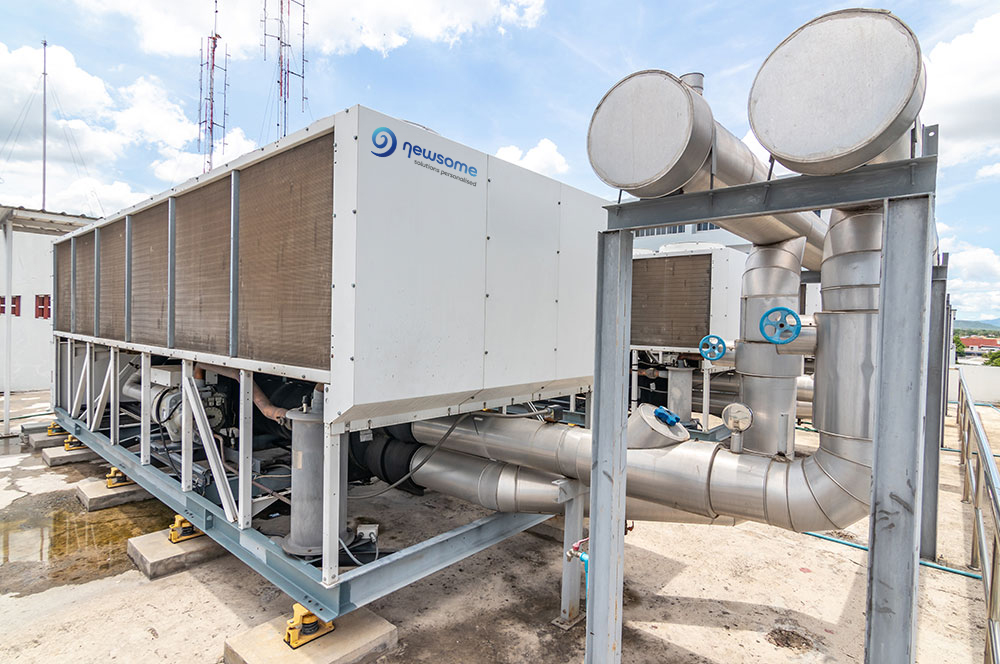As the colder months approach, it’s essential for businesses and industries that rely on chiller systems to consider the impact of low ambient temperatures on their equipment’s performance. Chillers play a vital role in maintaining optimal temperatures for various processes and applications, and failing to prepare them for winter can lead to inefficiencies, increased energy consumption, and even potential damage. If you are in any doubt about how to protect your chillers during colder months, contact the Newsome team and we will be more than happy to advise you.
Chillers are designed to remove heat from liquids or air, ensuring that the desired temperatures are maintained for industrial processes, HVAC systems, and other applications. However, when the ambient temperature drops significantly, chillers can face several challenges:
Reduced Efficiency: Cold temperatures can affect the efficiency of chillers, causing them to work harder to achieve the same cooling output. This increased workload can lead to higher energy consumption and operating costs.
Freezing Concerns: One of the most critical issues during winter is the potential for water or refrigerant lines to freeze. Frozen components can lead to blockages, pressure buildup, and even damage to the chiller’s internal parts.
Temperature Control: Cold weather can lead to temperature imbalances, causing inconsistencies in the chiller’s performance and affecting the quality of the cooling process.
To ensure that your chiller systems continue to operate efficiently during the winter months, follow these important steps:
Install proper insulation and enclosures around the chiller equipment to minimise heat loss and protect it from the cold weather. This can also help prevent the formation of condensation that might lead to freezing. Look at adding an antifreeze to limit any damage, the use of an industrial inhibited glycol and water mixture is recommended in most water chiller systems for this purpose. Ethylene and Propylene are the two standard types of inhibited glycols commonly used. The main job of glycol is to prevent freezing of the process fluid and ensure consistent flow at the lower operating temperature.
Whilst this can add to the running costs of your chiller, consider installing electric heaters or heat tracing systems on water and refrigerant lines to prevent freezing. These heaters will maintain the necessary temperatures and ensure a smooth flow of fluids. Adjust the chiller’s thermostat settings to accommodate colder ambient temperatures. This will help maintain consistent cooling performance while preventing unnecessary strain on the system. Schedule regular maintenance checks before the winter season to ensure all components are in optimal condition. Replace worn-out parts, check refrigerant levels, and ensure proper oil viscosity.
If possible, reduce the load on the chiller system during extremely cold weather. This can help alleviate strain and prevent overheating of components. Implement a remote monitoring system that alerts you to any abnormalities in chiller performance. Alarms can help you address issues promptly and prevent potential damage and finally, develop a comprehensive winterisation plan that outlines the specific steps to be taken before, during, and after the cold season. This plan should include procedures for shutdowns, restarts, and emergency scenarios.
Conclusion:
Protecting your chillers during the winter months is crucial for maintaining efficient operations and extending the lifespan of your equipment. By understanding the challenges posed by cold ambient temperatures and following the recommended tips, you can ensure that your chiller systems continue to deliver reliable cooling performance throughout the colder months. Taking proactive measures now can save you from costly chiller repairs and downtime in the long run, allowing your business to thrive even in the chill of winter.

